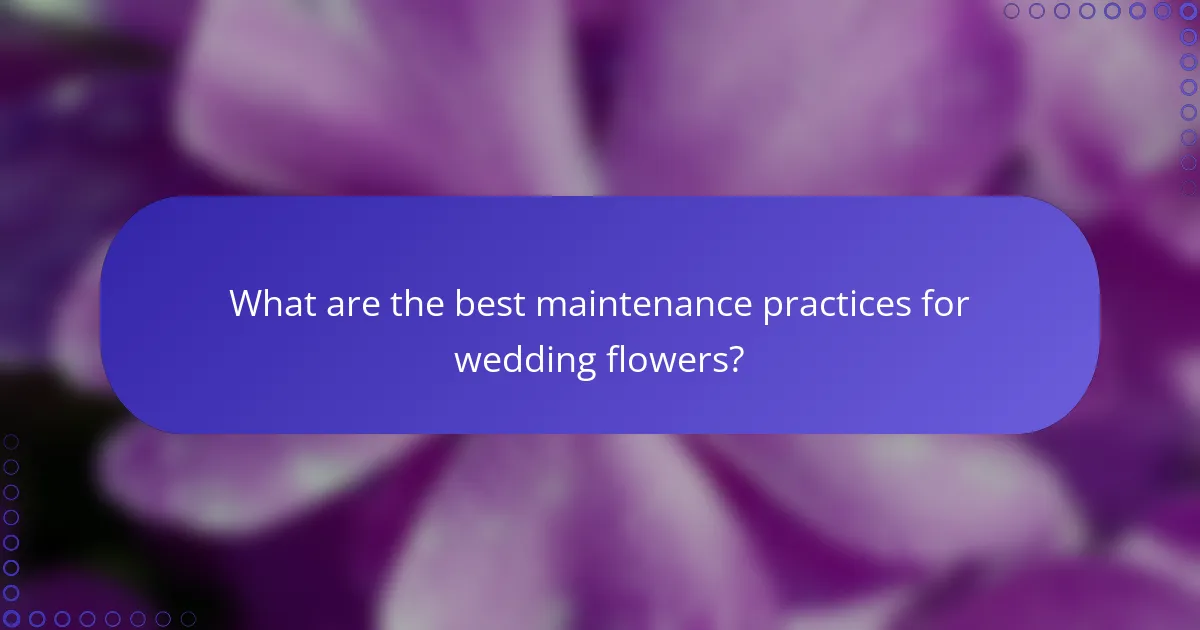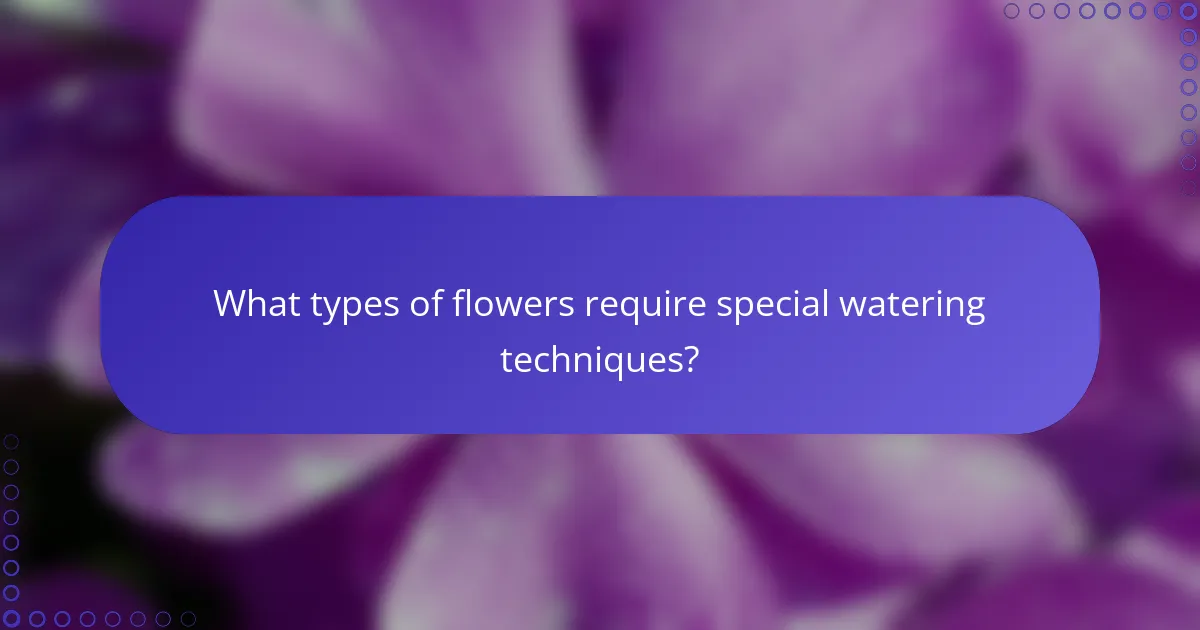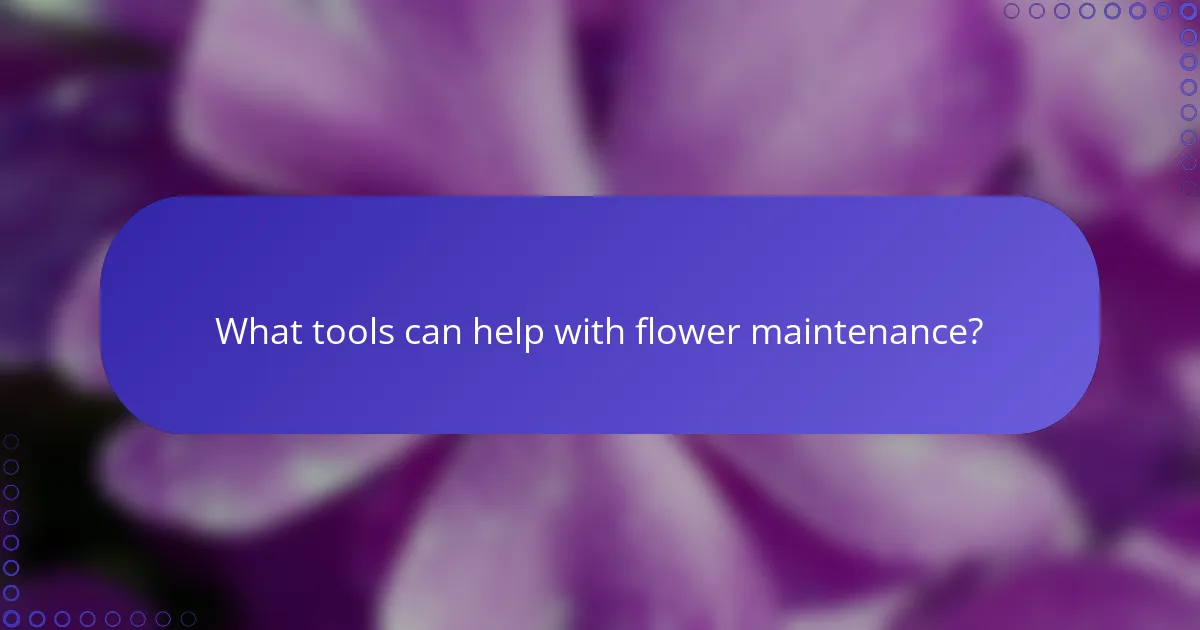Proper watering techniques and maintenance are crucial for keeping wedding flower arrangements fresh and vibrant. By focusing on the right temperature, timing, and soil moisture, you can enhance the appearance of your flowers on the big day. Regular care, including removing wilted leaves and changing water frequently, will ensure that your arrangements look their best throughout the event.

How to water wedding flower arrangements effectively?
To water wedding flower arrangements effectively, focus on using the right temperature and timing, while ensuring the soil moisture is balanced. Proper watering techniques help maintain the freshness and longevity of the flowers, enhancing their appearance on the big day.
Use room temperature water
Using room temperature water is essential for keeping wedding flower arrangements healthy. Cold water can shock the flowers, causing wilting or damage to delicate petals. Aim for water that is between 20-22°C (68-72°F) to provide a comfortable environment for the blooms.
Additionally, avoid using hot water, as it can lead to rapid evaporation and stress the flowers. Always check the temperature before watering to ensure optimal conditions.
Water early in the morning
Watering wedding flower arrangements early in the morning is ideal for maintaining their vibrancy. During this time, temperatures are cooler, which helps reduce evaporation and allows the flowers to absorb moisture effectively. This practice is especially beneficial in warmer climates.
By watering in the morning, you also give the flowers a chance to hydrate before the heat of the day sets in, ensuring they look their best for the event.
Check soil moisture regularly
Regularly checking soil moisture is crucial for the health of wedding flower arrangements. Stick your finger about an inch into the soil; if it feels dry, it’s time to water. This simple test helps prevent both underwatering and overwatering.
Consider using a moisture meter for more precise readings, especially if you have multiple arrangements. Maintaining consistent moisture levels will keep your flowers fresh and vibrant.
Avoid overwatering
Overwatering can be detrimental to wedding flower arrangements, leading to root rot and other issues. Ensure that the pots have proper drainage to allow excess water to escape. If the soil remains soggy, it can suffocate the roots and cause the flowers to wilt.
As a rule of thumb, water only when the top inch of soil feels dry. This practice will help maintain a healthy balance and prolong the life of your arrangements.
Use a watering can with a spout
A watering can with a spout is an effective tool for watering wedding flower arrangements. The spout allows for precise pouring, minimizing the risk of splashing water onto the petals, which can lead to damage or mold growth.
Choose a watering can that is easy to handle and has a comfortable grip. This will make the task of watering more efficient and help you maintain the beauty of your floral arrangements.

What are the best maintenance practices for wedding flowers?
To keep wedding flowers looking fresh and vibrant, regular maintenance is essential. Key practices include removing wilted leaves, changing the water frequently, trimming stems, and storing flowers in a cool environment.
Remove wilted leaves daily
Daily removal of wilted leaves helps prevent the spread of bacteria in the water, which can shorten the lifespan of your flowers. Inspect each arrangement and gently pull off any dead or yellowing foliage.
Additionally, this practice maintains the visual appeal of the flowers, ensuring that only the healthiest parts are on display. Regular checks can also help you identify any flowers that may need extra care.
Change water every two days
Changing the water every two days is crucial for maintaining the freshness of wedding flowers. Stale water can harbor bacteria, which can lead to wilting and decay.
When changing the water, rinse the vase thoroughly to remove any residue. Fill it with fresh, room-temperature water, and consider adding a floral preservative to extend the life of the blooms.
Trim stems at an angle
Trimming stems at an angle increases the surface area for water absorption, which is vital for keeping flowers hydrated. Use sharp scissors or a knife to make a clean cut, ideally about one to two inches from the bottom.
Perform this trimming every few days to ensure optimal water uptake. Avoid crushing the stems, as this can impede their ability to absorb water effectively.
Keep flowers in a cool place
Storing wedding flowers in a cool place is essential for prolonging their freshness. Ideal temperatures range from 15°C to 20°C (59°F to 68°F), away from direct sunlight and heat sources.
A cooler environment slows down the wilting process and helps maintain the flowers’ vibrant colors. If possible, use a refrigerator for short-term storage, but avoid placing them near fruits, as ethylene gas can cause premature wilting.

What types of flowers require special watering techniques?
Some flowers, like roses, lilies, and hydrangeas, have specific watering needs that can affect their growth and appearance. Understanding these requirements can help ensure that your wedding flower arrangements thrive.
Roses need deep watering
Roses thrive when they receive deep watering, which encourages their roots to grow deeper into the soil. This method typically involves watering them thoroughly once or twice a week, depending on the weather and soil conditions.
To check if your roses need water, dig a few inches into the soil; if it feels dry, it’s time to water. Avoid shallow watering, as this can lead to weak root systems and increased susceptibility to drought.
Lilies prefer less frequent watering
Lilies require less frequent watering compared to other flowers, as they are prone to root rot if overwatered. Water them only when the top inch of soil feels dry, which may mean watering every 7 to 10 days.
It’s essential to ensure good drainage in the soil to prevent standing water, which can harm the bulbs. Consider using a well-draining potting mix if planting in containers.
Hydrangeas need consistent moisture
Hydrangeas thrive in consistently moist soil, requiring regular watering to maintain their vibrant blooms. Aim to keep the soil evenly moist, especially during hot weather, which may mean watering several times a week.
Mulching around the base of hydrangeas can help retain moisture and regulate soil temperature. Be cautious not to let the soil dry out completely, as this can lead to wilting and stress on the plants.

How does climate affect flower watering needs?
Climate significantly influences the watering needs of flowers, as temperature and humidity levels dictate how much moisture plants require. In warmer and drier conditions, flowers typically need more frequent watering to thrive, while cooler and more humid climates may allow for less frequent irrigation.
Hot climates require more frequent watering
In hot climates, flowers lose moisture rapidly through evaporation and transpiration, necessitating more frequent watering. It’s advisable to check the soil moisture daily, especially during peak summer months, and water when the top inch feels dry.
Consider using drip irrigation systems or soaker hoses to deliver water directly to the roots, minimizing waste and ensuring that the plants receive adequate hydration. Adjust watering schedules based on temperature fluctuations; during extreme heat, you may need to water twice a day.
Humidity affects water retention
Humidity plays a crucial role in how well flowers retain water. In high-humidity environments, evaporation rates decrease, allowing soil to stay moist for longer periods. This means that watering can be less frequent, but it’s essential to monitor soil moisture levels to avoid overwatering.
In contrast, low-humidity conditions can lead to quicker drying of the soil, requiring more regular watering. A simple way to assess this is to feel the soil; if it feels dry a couple of inches down, it’s time to water. Mulching can also help retain soil moisture in both high and low humidity situations, providing a buffer against rapid evaporation.

What tools can help with flower maintenance?
Effective flower maintenance relies on a few essential tools that help keep arrangements fresh and vibrant. These tools enhance watering techniques and overall care, ensuring your flowers thrive for longer periods.
Floral spray bottles
Floral spray bottles are vital for maintaining humidity around flower arrangements. They allow for gentle misting, which can help prevent wilting and keep petals hydrated without over-saturating the soil.
When using a floral spray bottle, aim to mist the flowers lightly once or twice a day, especially in dry environments. Choose a bottle with an adjustable nozzle to control the spray intensity, ensuring you don’t drown the blooms.
Common pitfalls include over-spraying, which can lead to mold growth, and neglecting to spray altogether in dry conditions. A good practice is to check the moisture level of the soil and the humidity of the air before deciding on your misting schedule.

